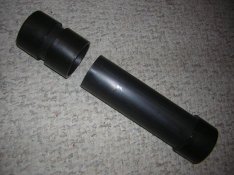Tubes
When I started developing 4x5, I did quite a bit of research on how to develop the film. My investigations led me to tube processing. If you'll go to the view camera store website and search for btzs tubes, you'll get the basic idea.
I use a 1.5 inch diameter ABS (black plastic) tube, cut down to about 4.5 inches long with a cap on one end and a male threaded adapter on the other.
The film gets rolled up, emulsion side in, and inserted into the tube. Some folks use a piece of fiberglass window screen between the film and tube to allow easier removal of the wet film from the tube.
A cap (containing your developer) is then threaded onto the tube, the whole thing is turned horizontally and put into a temperature controlled water bath, which allows you to "log roll" the tubes and get even distribution of the developer on the film.
When the development time is done, you turn off the lights, turn the tube with the cap down, remove it and put the tube in the stop bath. Then remove film and fix.
Look at this picture and I think you'll get the idea.
I heartily recommend the tubes, but just like anything they take a little practice to get used to.
I am sure others will explain this better than I did. Do some google searches and you'll find a ton of info on how to do this.
Regards,
Russell









 )
) .
.



